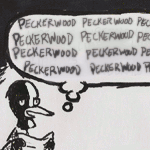|
http://www.theonion.com/article/scientists-develop-highly-volatile-new-relationshi-30385 Article made me think of this thread, which is sadly dying.
|
|
|
|

|
| # ? May 31, 2024 00:21 |
|
I guess once we got to buckyballs with 60 very unhappy nitrogen atoms we kind of reached peak FOOF. Have a crosspost from the Mechanical Failures thread that is somewhat on topic: TotalLossBrain posted:Some more gas stuff, this time from the Apollo program with its LOX rocket propellants (Liquid OXygen)
|
|
|
|
Gumbel2Gumbel posted:http://www.theonion.com/article/scientists-develop-highly-volatile-new-relationshi-30385 Most things that go near the compounds in this thread die
|
|
|
|
As long as there are disposable grad students in German research labs going boom, this thread lives on.
|
|
|
|
Wrong thread
|
|
|
|
i have been told of this thread id like to (theoretically/science fictionally) store liquid hydrogen in tanks in space you guys okay with me asking (dumb) questions about this? because i have alot fo dumb questions
|
|
|
|
anyone have a link to tables of saturation curves for different chemicals? specifically im looking for Ammonia Carbon Dioxide Carbon Monoxide Fluorine Heavy Water Hydrazine Hydrogen Hydrogen Deuteride Hydrogen Fluoride Hydrogen Peroxide Mercury Nitric Oxide Nitrogen Nitrogen Dioxide Nitrogen Trifluoride Nitrous Oxide Oxygen Semiheavy Water Sulfur Dioxide Tetrafluorohydrazine Water all molecular
|
|
|
|
Gumbel2Gumbel posted:http://www.theonion.com/article/scientists-develop-highly-volatile-new-relationshi-30385
|
|
|
|
I feel like that question stems from Children of a Dead Earth specifically.
|
|
|
|
|
M_Gargantua posted:I feel like that question stems from Children of a Dead Earth specifically.
|
|
|
|
i have discovered wolfram alpha nevermiiiind lamo!
|
|
|
|
Kinetica posted:As long as there are disposable grad students in German research labs going I have learned many things about nitrogen chemistry from this thread.
|
|
|
|
Baloogan posted:anyone have a link to tables of saturation curves for different chemicals? specifically im looking for A few beers.
|
|
|
|
Out of curiosity, is there such a thing as a ring of nitrogens with alternating single/double bonds? I presume the answer is "if there is, not for long" but I was wondering if someone could elaborate on what limits that kind of chemistry. If I remember my chem from decades ago, replacements happen when something wants the bond more than the current occupant - which is why some thread favorites like fluorine are so active, they're always happy to trade up.
|
|
|
|
Harik posted:Out of curiosity, is there such a thing as a ring of nitrogens with alternating single/double bonds? I presume the answer is "if there is, not for long" but I was wondering if someone could elaborate on what limits that kind of chemistry. If I remember my chem from decades ago, replacements happen when something wants the bond more than the current occupant - which is why some thread favorites like fluorine are so active, they're always happy to trade up. Yes, a nitrogen atom is isoelctronic with a CH and can replace them directly in aromatic compounds. Pyridine, for example, is just benzene with a nitrogen substituted for a CH - C5H5N. Instead of a hydrogen atom, there's a lone pair of electrons on the N which can be used for coordination or other stuff. The limits are that nitrogen is then using up its three bonds and you can't attach any functional groups without turning it into a polar salt. You also have the standard problem of nitrogen atoms wanting to make N2 molecules and blowing the whole thing up.
|
|
|
|
I changed majors to avoid taking Chem II, but I enjoy this thread. Somebody explain to me why nitrogen is so volatile.
|
|
|
|
Nitrogen hates. Basically It has three unpaired electrons, and when Nitrogen bonds break in a molecule, explosions happen because Nitrogen forms triple bonds with those electrons that have lots of energy in them. More electron bonds means more reactive.
|
|
|
|
Kwyndig posted:Nitrogen hates. Basically It has three unpaired electrons, and when Nitrogen bonds break in a molecule, explosions happen because Nitrogen forms triple bonds with those electrons that have lots of energy in them. More electron bonds means more reactive. Hates? It's more that it has an overabundance of self-love. One of the ultimate chemical onanists. vv Better and more accurate than mine. 
Munin has a new favorite as of 00:02 on Mar 31, 2017 |
|
|
|
Nitrogen is a racist monogamist. If at any point its not in a loving relationship with another single Nitrogen, it will do everything in the power of electromagnetism to get back to that state. Its hard to say just looking at it that triple bonds are or aren't stable or energetic because of geometry or strange orbital affinities, just look at N2 versus alkynes. Nitrogen goes boom precisely because of how efficient it is for nitrogen to just be hanging off a nitrogen and anywhere else nitrogen is just can't compare to the sublime nature of N2 e. The weasel answer is quantum mechanics did it because I think that's the first principles way to compare things like bond energies. zedprime has a new favorite as of 23:32 on Mar 30, 2017 |
|
|
|
Here, have something mildly foofy courtesy of the new car discussion thread in AI. https://euclidsbridge.wordpress.com/2011/11/21/drag-racing-pioneers-or-suicidal-nutjobs/ Apparently, guys were dropping hyrdazine into the fuel tanks of their nitromethane fueled dragsters in the 50s and 60s until the nhra banned it. The results were often... dramatic. 
Elmnt80 has a new favorite as of 06:12 on Mar 31, 2017 |
|
|
|
That's a loving gnarly read, thanks for the link.
|
|
|
|
Harik posted:Out of curiosity, is there such a thing as a ring of nitrogens with alternating single/double bonds? I presume the answer is "if there is, not for long" but I was wondering if someone could elaborate on what limits that kind of chemistry. If I remember my chem from decades ago, replacements happen when something wants the bond more than the current occupant - which is why some thread favorites like fluorine are so active, they're always happy to trade up. https://en.wikipedia.org/wiki/Hexazine "is a hypothetical allotrope of nitrogen composed of 6 nitrogen atoms arranged in a ring-like structure analogous to that of benzene" "it has been predicted computationally that the hexazine molecule is highly unstable" Ya don't say.
|
|
|
|
Since metallic hydrogen is a thing now, is metallic nitrogen possible? And would it be reactive or stable?
|
|
|
|
|
M_Gargantua posted:Since metallic hydrogen is a thing now, is metallic nitrogen possible? And would it be reactive or stable? Are there enough grad students in the world to find out?
|
|
|
|
Bertrand Hustle posted:Are there enough grad students in the world to find out? Ia Ia Klapötke F'taghn.
|
|
|
|
M_Gargantua posted:Since metallic hydrogen is a thing now, is metallic nitrogen possible? Not really. Hydrogen is Group 1 alongside metals like Lithium and Sodium. Nitrogen is Group 5 and definitely a nonmetal. It's just too electronegative to act like a metal.
|
|
|
|
The Lone Badger posted:Not really. Hydrogen is Group 1 alongside metals like Lithium and Sodium. Nitrogen is Group 5 and definitely a nonmetal. It's just too electronegative to act like a metal. Wrong. If you put enough pressure on anything it'll become metallic. https://arxiv.org/abs/1210.4358 http://iopscience.iop.org/article/10.1088/1367-2630/15/1/013010/meta https://www.scientificamerican.com/article/pressure-turns-nitrogen-g/
|
|
|
|
zedprime posted:Nitrogen is a racist monogamist. If at any point its not in a loving relationship with another single Nitrogen, it will do everything in the power of electromagnetism to get back to that state. Tread title should be Things that go FOOF in the night: A loving relationship with nitrogen
|
|
|
|
Carbon dioxide posted:Wrong. If you put enough pressure on anything it'll become metallic. Very true: Lemmy was formed when a nerdy British chem grad student got stuck in a 25k PSI reactor vessel.
|
|
|
|
Hey, I feel like this would be the place to ask- is there some phone app that you can use to look up the little number codes in the diamonds on tanker trucks to see what they're carrying? I don't know what those codes are actually called, and I'm sure that 99% of them are just gasoline, but it'd be neat to look up what a truck is transporting if you're bored in the passenger seat.
|
|
|
|
Luneshot posted:Hey, I feel like this would be the place to ask- is there some phone app that you can use to look up the little number codes in the diamonds on tanker trucks to see what they're carrying? I don't know what those codes are actually called, and I'm sure that 99% of them are just gasoline, but it'd be neat to look up what a truck is transporting if you're bored in the passenger seat. I guess you can look for an app at the NFPA site but here's a link to what they mean: http://people.howstuffworks.com/question327.htm
|
|
|
|
Luneshot posted:Hey, I feel like this would be the place to ask- is there some phone app that you can use to look up the little number codes in the diamonds on tanker trucks to see what they're carrying? I don't know what those codes are actually called, and I'm sure that 99% of them are just gasoline, but it'd be neat to look up what a truck is transporting if you're bored in the passenger seat. Those are defined by NFPA 704 and commonly called “fire diamonds”. The different quadrants tell you how hazardous the substance is in various ways. They don’t uniquely identify chemicals, but you can make an educated guess. 
|
|
|
|
The NFPA do have an app but I have no idea how easy it is to use to look up codes.
|
|
|
|
I think they're asking about DOT placards which usually include UN ID numbers that do uniquely identify chemicals. There are apps but I have no personal experience with any of them.
|
|
|
|
Oh, those. ERG 2016 on iOS seems to do what you want. e: “What’s in that truck?” is simpler and also works.
|
|
|
|
Don't text and drive. Especially around a truck with DOT placards. Or look up dot placards while driving.
|
|
|
|
9260 is underrated.
|
|
|
|
Mustached Demon posted:Don't text and drive. Especially around a truck with DOT placards. Or look up dot placards while driving. Get a dashcam and hook it into text to speech.
|
|
|
|
Carbon dioxide posted:Wrong. If you put enough pressure on anything it'll become metallic.
|
|
|
|

|
| # ? May 31, 2024 00:21 |
|
zedprime posted:The weasel answer is quantum mechanics did it because I think that's the first principles way to compare things like bond energies. Nitrogen has 7 total electrons. A single, unbonded nitrogen atom in its ground state would have 2 electrons in the 1s state, 2 in the 2s state, and 3 in the 2p state. The 2p state can have up to 6 electrons. So, if you put two N atoms together and let them share valence electrons, you have 6 total electrons shared between the two atoms. The "half" of each wave function near one nucleus or the other would fill the energy level. As a rule of thumb, whenever you have filled shells systems are unusually stable, because you've put the most particles in the lowest energy you can. I'm sure that sounds pretty hand-wavy but estimating electron energies in a molecule by adding up atomic orbitals is real, if highly approximate.
|
|
|














































